Quebec MPs line up to oppose province’s riding map proposal
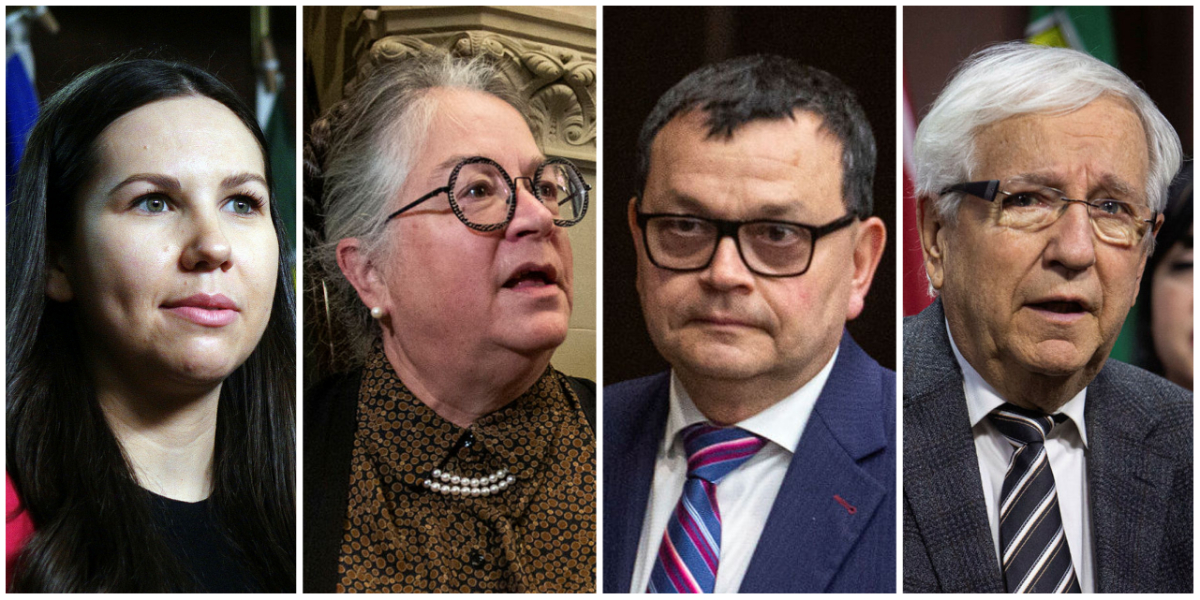
The Procedure and House Affairs Committee is set for a busy hearing on the final proposed new electoral map for Quebec, with MPs from across the province set to raise objections.
The committee will hear particular pushback from those representing the eastern region, where commissioners have upheld their decision to remove and reallocate a seat.
“We thought we had good arguments [during the public hearings], we thought that we may have a chance to change their opinion on this, but they still came back with the same proposal to get rid of the riding I’m representing right now,” said Bloc Québécois MP Kristina Michaud, who’s represented the eastern Quebec riding of Avignon–La Mitis–Matane–Matapédia since 2019.
Michaud said she and other MPs and regional elected officials who had “led a fight” during the public hearings were surprised and “sad” to see the Quebec redistribution commission didn’t reverse course in the final proposal tabled in the House of Commons on Feb. 1.
If it goes ahead, Avignon–La Mitis–Matane–Matapédia will essentially be wiped off the electoral map.
As put forward in the initial draft published in late July, the riding is set to have its eastern end absorbed by Gaspésie–Les Îles-de-la-Madeleine—currently represented by National Revenue Minister Diane Lebouthillier—which would pick up the regional county municipalities (RCMs) of La Matanie and Avignon. The initial proposal also had the Gaspésie riding pick up the RCM of La Matapédia, but the final version has La Matapédia, along with La Mitis, instead combined with the eastern half—made up of the RCMs of Les Basques and Rimouski-Neigette—of the current riding of Rimouski-Neigette–Témiscouata–Les Basques, which would be renamed Rimouski–La Matapédia. Témiscouata would join the RCMs of Rivière-du-Loup, Kamouraska, L’Islet, and Montmagny to form Montmagny–Témiscouata–Kataskomiq.
While Quebec had originally been set to lose one of its 78 federal seats through the redistribution process, legislative changes were introduced in 2021 to protect its current seat count. But, as a result of population shifts, commissioners want to remove a riding in the east to create a new seat—the proposed Les Pays-d’en-Haut—in the Laurentians and Lanaudière region in the west.
Altogether, the region would go from four federal seats to three. A similar reduction was proposed by the last redistribution commission, but was ultimately reversed.

“It will be a loss for people that are in that region,” said Michaud. “We’re losing political power, political leverage.”
Michaud attended the public hearings in Gaspé, to listen, and in Matane, where she spoke.
“I had a chance to explain myself for maybe one minute [more] than they usually allow, so I thought it was a good sign for the commission, but it wasn’t,” she said.
Michaud argued that not only is the territory in eastern Quebec large, there are people spread “all over” it, unlike other geographically large ridings, where populations are generally concentrated in particular parts of the riding.
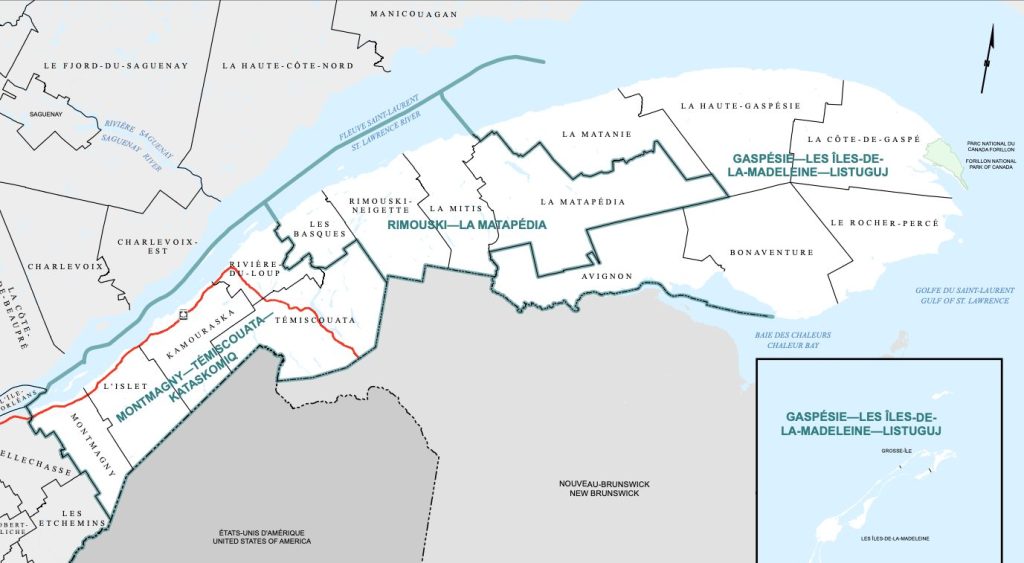
The Electoral Boundaries Readjustment Act charges commissions to, among other things, “make every effort” to keep the population of each riding within a 25 per cent variance above or below the provincial quota. With 78 seats and a population of 8.5 million people, the electoral quota for Quebec is 108,998 people per riding. Between 2011 and 2021, the populations of Avignon–La Mitis–Matane–Matapédia and Gaspésie–Les Îles-de-la-Madeleine declined some 4.7 per cent and as a result, under current boundaries, they’re 30.3 per cent and 35.5 per cent, respectively, below the quota. As noted in its report, the Quebec commission aimed to have ridings be as close to a 10 per cent variance as possible.
Michaud and others argued for exceptions to be made for “extraordinary circumstances,” as is allowed under the act and has been done for other ridings in Canada (like Saskatchewan’s northernmost riding, Desnethé–Missinippi–Churchill River, the population of which is 53.2 per cent below that province’s quota).
In their final report, commissioners noted that exception has only been used 12 times since being introduced in 1986, and said the current size of the Gaspé ridings doesn’t justify use this time around.
Overall, they heard from 161 individuals, including 34 MPs and 41 municipal officials, during 20 public hearings held between Sept. 6 and Oct. 13, 2022, with more than 300 comments and submissions received.
“Reactions to the idea of eliminating one electoral district were numerous, firm and unanimously negative,” reads the report, with the commission criticized for “thinking solely in terms of numbers” and “parity of electoral power.”
Many participants urged it “to disregard the numerical criterion of the electoral quota (‘one person, one vote’) in favour of the more subjective criteria of effective representation, community of interest and regional community of identity.”
But the commission argued the concept of “community of interest” is a broad term and that the “fundamental principle governing” the redistribution process is equality of electoral weight, highlighting a 1991 Supreme Court ruling that “makes it clear that the ‘primary’ requirement for effective representation is still relative parity of voting power.”
Michaud said she’s spoken with both Lebouthillier and Conservative MP Bernard Généroux (Montmagny–L’Islet–Kamouraska–Rivière-du-Loup, Que.) and is “happy” both have expressed a desire to work together to fight the change.
“It’s good news that it’s not just the fight of one MP” or party, she said.
MPs have 30 days after a report is tabled in the House to file an objection at PROC, which requires the backing of 10 other Members of Parliament. After PROC hears from MPs, it reports back to the House with its final recommendations, which are then sent to commissions to consider before the new riding maps are finalized. For Quebec, those 30 days run out in March.
“We are looking at how to proceed,” Michaud said, whether it’s better to go one by one, or as a team. Within their arsenal, she noted, is a motion adopted by Quebec’s National Assembly on Feb. 7 condmending the proposal. While she lamented not being able to speak directly to the commission, she said she’s hopeful in that she’ll be speaking to MPs “who can put themselves in my position.”
Lebouthillier’s office confirmed she’ll raise an objection at PROC.
It’s not just Gaspé Peninsula MPs who plan to appear before the committee.
Bloc Québécois MP Louis Plamondon (Bécancour–Nicolet–Saurel, Que.) said he’s already collected the 10 signatures needed to raise an objection.
In an email to The Hill Times, Plamondon said he’ll argue against the proposed addition of three municipalities on the eastern end of his riding—Villeroy, which is currently in Mégantic–L’Érable, and Leclercville and Val-Alain, which are currently in Lévis–Lotbinière—that he said want to stay in their current ridings. All three were moved in the final draft. The commission has also proposed renaming Plamondon’s riding as Bécancour–Saurel–Odanak.

Plamondon said he’ll make a case against both the name change and these additions, and understands the cities’ current MPs also plan to argue against their loss.
Conservative MP Jacques Gourde’s (Lévis–Lotbinière, Que.) office confirmed he intends to file an objection.
Between the Mégantic and Bécancour ridings, Lévis–Lotbinière is set to lose its western half, with the RCM of Lotbinière divided between the three. Under the final proposal, Mégantic–L’Érable—which also includes the RCMs of L’Érable, Les Appalaches, Le Granit, and part of Le Haut-Saint-François—would stretch from the United States border to the St. Lawrence River.
Plamondon noted “there is a great deal of dissatisfaction” with the final redistribution proposal for Quebec overall, in particular when it comes to the loss of a riding in the east.

Bloc Québécois MP Alexis Brunelle-Duceppe (Lac-Saint-Jean, Que.) has also indicated plans to raise an objection over the “shock” changes proposed in his area of the province in the final draft.
Unlike the initial proposal, the final one would combine the city of Alma—which is currently in Lac-Saint-Jean—with the municipalities of Jonquière and Larouche to form Jonquière–Alma.
The current riding of Jonquière stretches north from the city to include all of the RCM of Le Fjord-du-Saguenay that’s north of the Saguenay River, with the smaller riding of Chicoutimi–Le Fjord capturing south of the river. The new version of Chicoutimi–Le Fjord would encompass almost the entire RCM, north and south of the river (aside from a small chunk being added to Lac-Saint-Jean).
Final Alberta proposal sees some changes walked back
Alberta’s redistribution commission tabled its final report on Feb. 2, with a number of notable proposals walked back.
The province is adding three seats overall, bringing it to a total of 37. Ontario and British Columbia will also add one seat each through this decade’s redistribution process, bringing the House of Commons to 342 seats.
In central Alberta, the addition of two new ridings—one outside of Edmonton, and one around Airdrie—will still cause a notable shake-up to boundaries in the region, but less so in the final draft.
Initially, commissioners pitched combining Spruce Grove and Stony Plain, which are currently in Sturgeon River–Parkland, with Devon and Leduc, which are currently in Edmonton–Wetaskiwin, to create Spruce Grove–Leduc east of Edmonton. Wetaskiwin would have instead been combined with Ponoka, Lacombe, Blackfalds, and Sylvan Lake—which are currently in Red Deer–Lacombe—to create Wetaskiwin Lacombe.
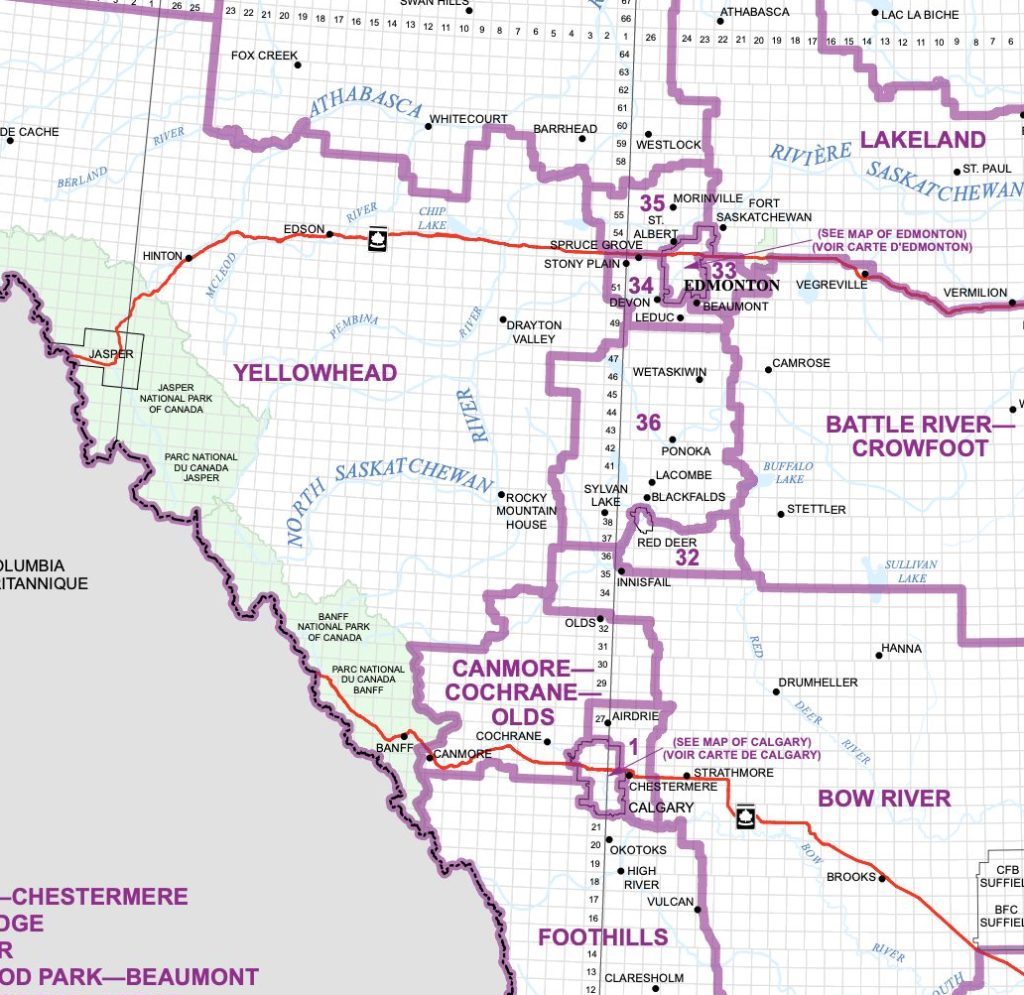
Speaking with The Hill Times last June, Conservative MP Mike Lake (Edmonton–Wetaskiwin, Alta.), whose current territory would have been split between seven different ridings, criticized the proposal, arguing it “completely” disregarded historic boundaries and combined communities that “don’t have much in common.”
In the final version, Devon, Leduc, and Beaumont (which was to be added to the current riding of Sherwood Park–Fort Saskatchewan) will stay together with Wetaskiwin in a riding to be renamed Leduc–Wetaskiwin (it will still lose the parts of the city of Edmonton that it currently holds).
The new riding near Edmonton will instead be geographically much larger and be named Parkland, spanning from the city’s western edge past Chip Lake and including the cities of Spruce Grove, Stony Plain, and Drayton Valley (which is currently in Yellowhead).
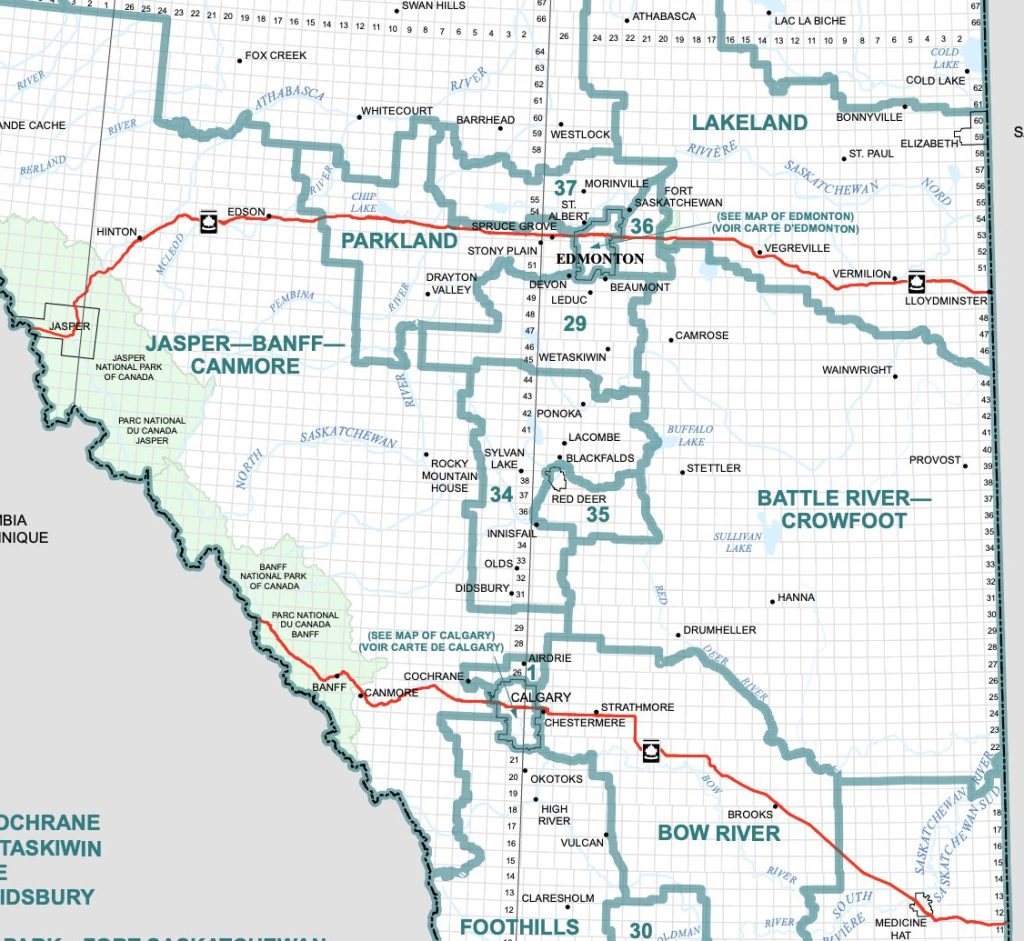
Ponoka, Lacombe, Blackfalds, and Sylvan Lake will stay together, and combine with Innisfail, Olds, and Didsbury—which are currently in Red Deer–Mountain View—to create Ponoka–Didsbury. The city of Red Deer will still get its own riding (combining the city with rural areas to the east and south) under the final proposal.
Commissioners had originally suggested that the new riding near Airdrie wrap around Calgary to the east and north, combining Airdrie with Chestermere (which is currently in Bow River). The final draft restores Chestermere to Bow River, with Airdrie instead paired with Cochrane to form Airdrie–Cochrane. The current riding of Banff–Airdrie, which has been represented by Conservative MP Blake Richards since being constituted in 2015, includes both Airdrie and Cochrane, along with Canmore and Banff National Park.
Despite the new riding of Parkland eating up a chunk of its northeastern corner, the current riding of Yellowhead is still set to get much larger. The final proposal would see it pick up Canmore and ground south of the city that’s currently in the riding of Foothills, in addition to Banff National Park, and be renamed Jasper–Banff–Canmore.
“It looks like the commission made some changes, accepted some of the feedback that came from their proposals, showed a certain level of flexibility,” said pollster Dan Arnold, chief strategy officer of Pollara Strategic Insights, who’s originally from Alberta.
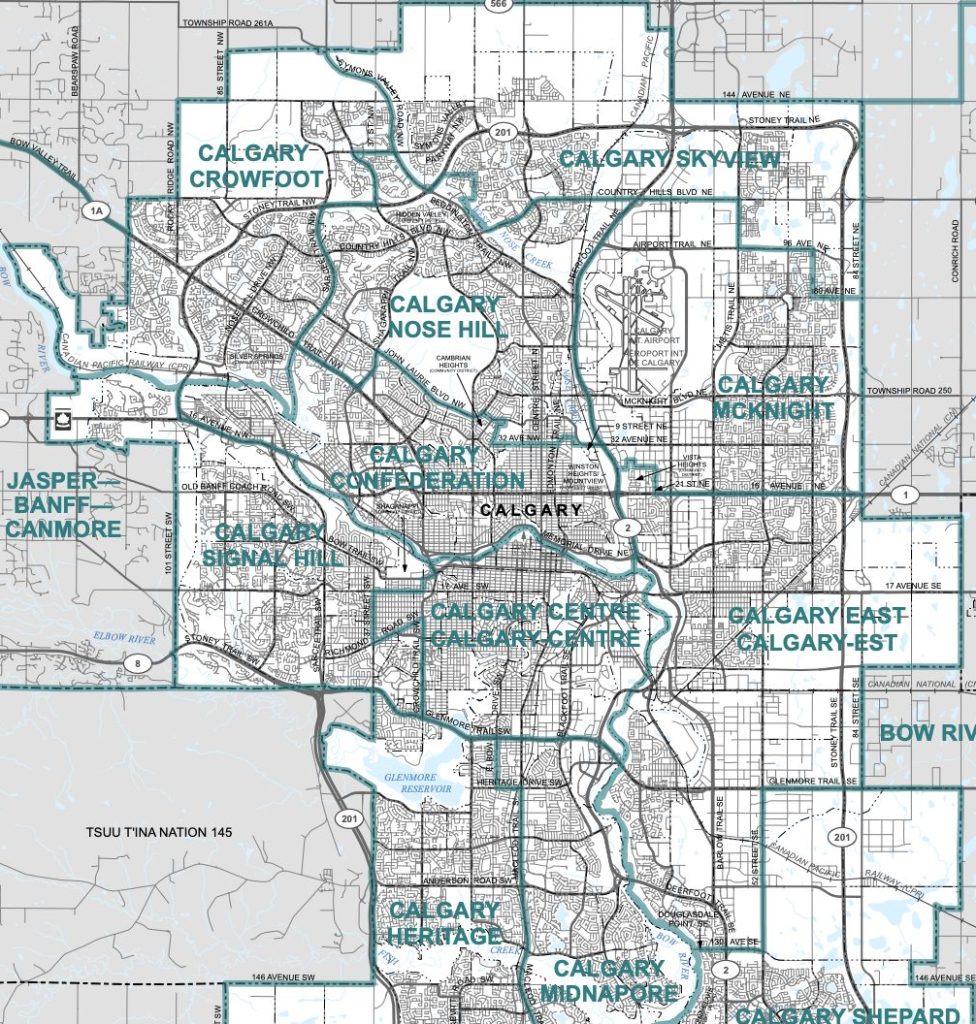
In Calgary, different borders are now on the table for Calgary McKnight, the new riding being added to the city’s west end. Combining residential area between 96 Avenue and 16 Avenue that’s currently split between Calgary Forest Lawn and Calgary Skyview, the final version of Calgary McKnight would see it also pick up the Calgary Airport and surrounding area from the latter. Calgary Skyview is will add the northern end of the city east of Symons Valley Road and north of Country Hills Boulevard, except for a small neighbourhood that’s been returned to Calgary Nose Hill.
Arnold, who was previously head of research in Prime Minister Justin Trudeau’s (Papineau, Que.) office, said the new boundaries for Calgary McKnight seem like “more of a natural fit in terms of keeping similar communities, neighbourhoods together,” and based on previous electoral results, the riding seems set to be a “relatively strong Liberal riding.” He guessed it’s where current Calgary Skyview Liberal MP Geroge Chahal will likely look to run.
Overall, though, Arnold said given where all five new seats are being added, the Conservatives stand to gain the most from this redistribution effort, including in the Tory stronghold province of Alberta.
“I think by and large … [it’s] probably going to wind up with a better national map for them post redistribution,” he said.
The Hill Times






 LICENSING
LICENSING PODCAST
PODCAST ALERTS
ALERTS













